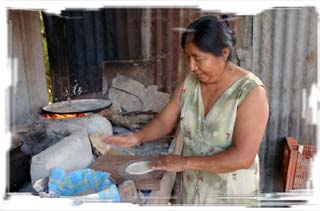
April, 2004
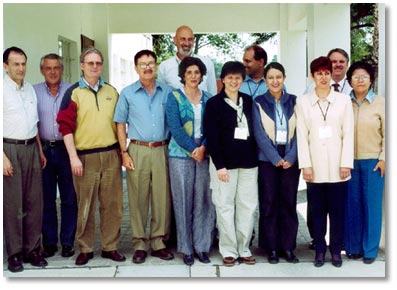 Although CGIAR centers share common human resources problems, do they communicate with each other and share successful solutions? Now five of them do just that, as partners in the Strategic Advisory Service for Human Resources (SAS-HR), says SAS-HR Director N.P. Rajasekharan.
Although CGIAR centers share common human resources problems, do they communicate with each other and share successful solutions? Now five of them do just that, as partners in the Strategic Advisory Service for Human Resources (SAS-HR), says SAS-HR Director N.P. Rajasekharan.
Representatives from CIAT, CIMMYT, IPGRI, IWMI, and WorldFish attended the first business meeting of the Advisory Group for the SAS-HR from 14–16 April at CIMMYT-Mexico. These five centers and the CGIAR Secretariat are part of an initiative to develop a CGIAR human resources framework and meet management needs. The ultimate goal is to achieve each center’s vision through the development of high caliber, committed, and motivated staff.
“In talking about those common problems we did find a big convergence,” says conference participant Koen Geerts, IPGRI’s Director of Finance and Administration. “Why not exchange information rather than re-inventing wheels…and sometimes the wrong wheels?”
Geerts thinks it was a big accomplishment for the centers to come together and discuss shared problems. He also thinks the SAS-HR will benefit other centers, which may want to join after the group makes progress and produces results.
Sharing Best Practices
A highlight of the conference’s first day was a best practice showcase, where each center presented its most successful human resources strategies. IMWI focused on its implementation of the OneStaff approach, which was also mentioned as one of IPGRI’s strengths; WorldFish explained its job evaluation system; and CIAT presented its use of the Internet for recruitment, occupational health program, and Social Welfare Fund. CIMMYT described its national staff administration, corporate policies, and management of a recent downsizing.
“I think CIAT has got a very sound policy and practice in place covering occupational health and safety,” says conference participant Doug Dunstan in giving an example of how the centers can learn from each other’s best practices. “We can build on their learning and implement many of these things without having to invest huge amounts of time.”
Dunstan, the Associate Director General for Corporate Services at WorldFish, thinks the SAS-HR will help introduce a higher level of equity in the CG system and show that staff members are valuable resources that need to be looked after.
“The main thrust will be one of harmonization and drawing out some very important themes that must permeate all of the CG system,” says Dunstan. He thinks the meeting was productive in defining project focuses and establishing a plan with detailed milestones. The openness and professionalism among participants impressed him, particularly while discussing sensitive issues.
Off to a Rapid Start
Rajasekharan is optimistic that the SAS-HR will help centers attract, motivate, develop, and retain the people who will accomplish center and CGIAR missions. “We want to foster more teamwork, transparency, and inclusiveness within the CGIAR,” he says. “We started looking at strategic issues and common concerns for the centers last December.”
Participating centers save time and costs by sharing ideas, strategies, and solutions. Using staff and management input, they are already defining human resources needs, developing strategies that recognize center diversity and autonomy, creating solutions, and establishing an e-community of HR professionals.
“The advisory group for SAS-HR is on track to address my main expectations,” says CIAT Director General Joachim Voss. “I hope they will help us to create sensible, effective, and cost-saving changes.”
More Effectives and Equity for CGIAR Center Staff
To ensure CGIAR success, centers must display not only excellence in science but also organizational effectiveness, according to CIMMYT Director General Masa Iwanaga, who opened the meeting. Other speakers included the World Bank’s Eric Schlesinger, who talked about 360-degree appraisal, and CGIAR Director Francisco Reifschneider with Ravi Tadvalkar, who addressed developments in the first CGIAR system-wide compensation survey via video.
“People are the foundation of our knowledge-based CGIAR system,” said Reifschneider. He endorsed the “OneStaff” initiative, which aims to create an inclusive and equitable environment for all staff members regardless of employment contract differences. The initiative will promote transparency by providing equal opportunities and clearly explaining benefit differences to staff. It could facilitate movement from National to Regional to International staff categories by clearly defining what is needed for advancement.
Reifschneider observed that OneStaff will “further develop and support the vision and values that SAS-HR participating Centers have for their staff.” He noted that “the concept behind OneStaff requires a gradual transition in the organizations, part of the evolution of the CGIAR System as a whole.”
Many staff members inquire about “what is going on” within an organization, and management has the challenge of finding the best ways to communicate clearly with everyone, says WorldFish Director General Stephen Hall. “We have to work hard to make it clear where the organization is going and what it is trying to do,” says Hall. He also advocates a transparent framework with open terms for compensation and recognition that bases differentiations not on place of birth or recruitment but rather on what people do for the organization.
If staff members want to voice opinions, they can take advantage of another SAS-HR project: a shared website named PeoplePower that has internal and public components. This tool will improve communication among staff members and management at the five centers. The public site will list vacancy postings and CV postings along with explanations of human resource practices and other features. The internal site will help staff share information, make suggestions, post events, and implement on-line processes such as training and opinion surveys. The website’s prototype, which was introduced at the meeting, includes a database for center policies, e-learning tools, and a virtual resource center.
Planning for Change
Although developing new ideas and approaches will not be difficult, says Geerts, the challenge lies in getting people to accept change. He says clinging to an established way of working is a human reaction, and people will only permit change if they believe it is positive.
Dunstan agrees. “Change is a concept which is not readily understood or accepted by a large body of people,” he says. “It’s human nature not to accept initiatives because they are in fact a change from the status quo.”
Geerts sees many best practices emerging from this effort, and he thinks it is vital to think ahead and plan for centers’ needs in five or ten years. “There’s a whole range of crucial HR-related matters on which we need to make progress,” he says. “This is only a start.”
Other meeting participants included Jesús Antonio Cuellar, Carlos Meneses, and Gustavo Peralta from CIAT; Coen Kramer, Martin van Weerdenburg, Marisa De la O, Georgina Becerra, and Patricia Villaseñor from CIMMYT; Khar Hoay Tan from WorldFish; and Griselda Marquez from SAS-HR.
What’s Next?
The next SAS-HR meeting is scheduled for 6-8 June in Colombo, Sri Lanka, at IWMI. IWMI has been working on the OneStaff concept and on the reformation of policies and practices, according to Director General Frank Rijsberman. He believes that the CGIAR can improve impacts in the areas where it works and also its position in the labor market by reforming HR policies
The June meeting will include presentations about the PeoplePower website, mainstreaming Gender and Diversity and knowledge management, results of a CGIAR-wide compensation survey, and a review of the projects. Human resources professionals from non-participating centers are invited to attend. The next SAS-HR Advisory Group meeting will be 25 October in Mexico during the Annual General Meeting.
To foster wider learning within the CGIAR, many SAS-HR meetings and initiatives will be open to all centers. For more information, contact N.P. Rajasekharan.
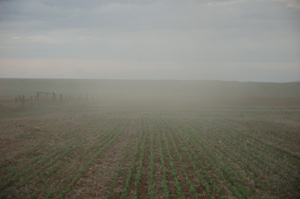 Zero-tillage trials in rainfed, winter wheat-fallow systems show smallholder farmers on the Anatolian Plains a way to double their harvests.
Zero-tillage trials in rainfed, winter wheat-fallow systems show smallholder farmers on the Anatolian Plains a way to double their harvests.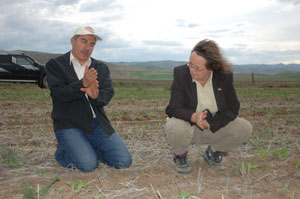
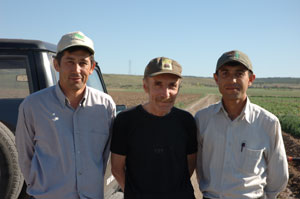 Retired agronomist Mufit Kalayci, recently brought back to the Anatolian Agricultural Research Center in Eskisiher, Turkey, to mentor a new team, sees the value of zero-tillage in intensive, irrigated systems with more than a single crop per year, but is skeptical about using it with traditional rainfed wheat farms. “I don’t think you can retain enough moisture over the fallow period.” he says. For that reason, one of the goals of the zero-tillage experiment was to see if a second crop other than weeds could be grown during the fallow season. This question will be answered in coming years.
Retired agronomist Mufit Kalayci, recently brought back to the Anatolian Agricultural Research Center in Eskisiher, Turkey, to mentor a new team, sees the value of zero-tillage in intensive, irrigated systems with more than a single crop per year, but is skeptical about using it with traditional rainfed wheat farms. “I don’t think you can retain enough moisture over the fallow period.” he says. For that reason, one of the goals of the zero-tillage experiment was to see if a second crop other than weeds could be grown during the fallow season. This question will be answered in coming years.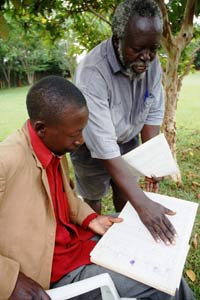 Farmers and community leaders in Kenya’s most densely-populated region have organized to produce and sell seed of a maize variety so well-suited for smallholders that distant peers in highland Nepal have also selected it.
Farmers and community leaders in Kenya’s most densely-populated region have organized to produce and sell seed of a maize variety so well-suited for smallholders that distant peers in highland Nepal have also selected it.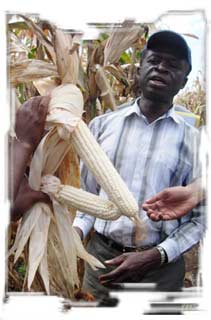 Ethiopia’s highland maize farmers now have a reason to smile—two reasons, as a matter of fact. Argene and Hora, recently released highland maize varieties, are spurring renewed hope for the country’s agricultural productivity.
Ethiopia’s highland maize farmers now have a reason to smile—two reasons, as a matter of fact. Argene and Hora, recently released highland maize varieties, are spurring renewed hope for the country’s agricultural productivity.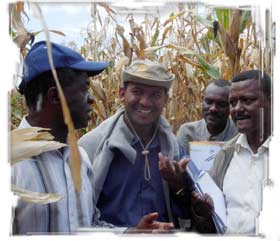
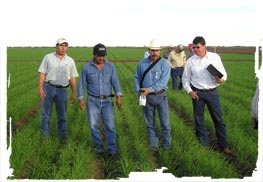 CIMMYT shows technology to enhance farmer income and reduce ocean pollution
CIMMYT shows technology to enhance farmer income and reduce ocean pollution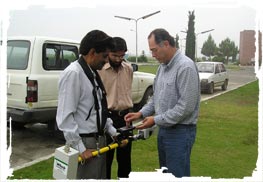
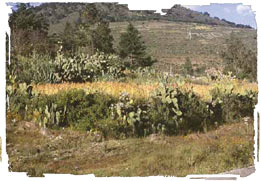 In Mexico, the wheat of the conquistadors helps scientists in their battle against drought.
In Mexico, the wheat of the conquistadors helps scientists in their battle against drought.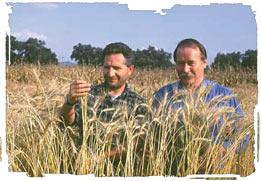
 Although CGIAR centers share common human resources problems, do they communicate with each other and share successful solutions? Now five of them do just that, as partners in the Strategic Advisory Service for Human Resources (SAS-HR), says SAS-HR Director N.P. Rajasekharan.
Although CGIAR centers share common human resources problems, do they communicate with each other and share successful solutions? Now five of them do just that, as partners in the Strategic Advisory Service for Human Resources (SAS-HR), says SAS-HR Director N.P. Rajasekharan.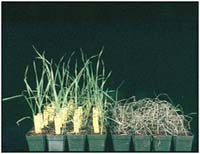
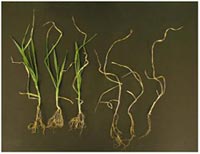 DREB plants (left) next to non-DREB plants (right) in the trial.
DREB plants (left) next to non-DREB plants (right) in the trial.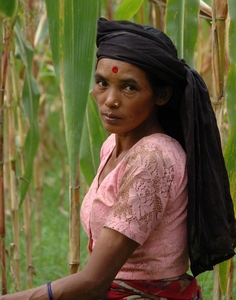 More than two decades of joint efforts between researchers from Nepal and CIMMYT have helped boost the country’s maize yields 36% and those of wheat by 85%, according to a report compiled to mark the 25th anniversary of the partnership. As a result, farmers even in the country’s remote, mid hill mountain areas have more food and brighter futures.
More than two decades of joint efforts between researchers from Nepal and CIMMYT have helped boost the country’s maize yields 36% and those of wheat by 85%, according to a report compiled to mark the 25th anniversary of the partnership. As a result, farmers even in the country’s remote, mid hill mountain areas have more food and brighter futures.
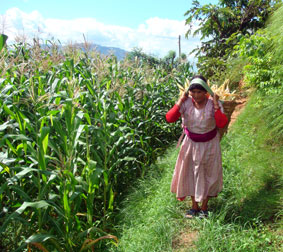 During 1997-2008,
During 1997-2008,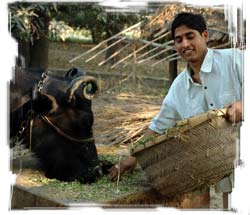 A daring move by a young farmer in India has changed his life and his father’s.
A daring move by a young farmer in India has changed his life and his father’s.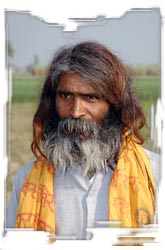
 Scientists talk wheat at the place where the green revolution began
Scientists talk wheat at the place where the green revolution began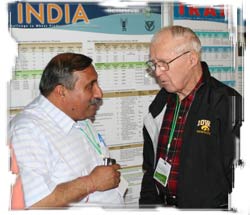
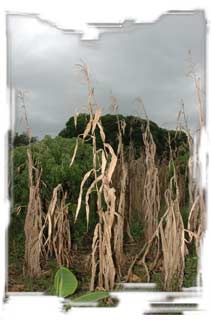 A CIMMYT scientist is working to see if instead of replacing old varieties with “new and improved”, it is possible to combine the best of the new while retaining the old.
A CIMMYT scientist is working to see if instead of replacing old varieties with “new and improved”, it is possible to combine the best of the new while retaining the old.